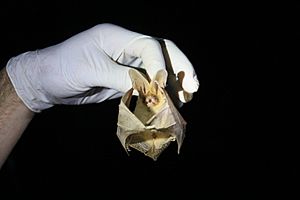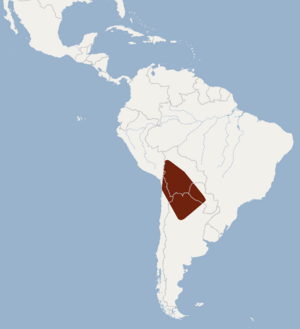Thomas's big-eared brown bat facts for kids
Quick facts for kids Thomas's big-eared brown bat |
|
|---|---|
 |
|
| Conservation status | |
| Scientific classification | |
| Genus: |
Histiotus
|
| Species: |
laephotis
|
 |
|
The Thomas's big-eared brown bat (Histiotus laephotis) is a type of vesper bat that lives in South America. These bats are known for their very large ears, which help them hear well.
Contents
About Thomas's Big-Eared Brown Bat
How it was Discovered
This bat was first described as a new species in 1916 by a British zoologist named Oldfield Thomas. He studied bat specimens that were kept at the Turin Museum of Natural History. These specimens were collected by "Dr. Borelli," who was likely Dr. Alfredo Borelli. Dr. Borelli gathered many animal samples from countries like Argentina, Paraguay, and Bolivia.
The first bat specimen used to describe the species was found in Caiza, Bolivia. This area is in the Potosí Department of Southern Bolivia.
What its Name Means
The bat's scientific name is Histiotus laephotis. The name Histiotus means "sail ear." This comes from ancient Greek words meaning "mast" and "ear," referring to its large, sail-like ears.
The meaning of "laephotis" is not fully clear. One idea is that it comes from Greek words meaning "awkward" and "light." This might refer to how the bat flies during the day, perhaps looking a bit clumsy.
Is it a Separate Species?
For a while, scientists debated if Thomas's big-eared brown bat was its own species. Some thought it was a subspecies of the big-eared brown bat (H. macrotis). Later, others thought it was a subspecies of the small big-eared brown bat (H. montanus). Today, most experts agree that it is a unique and valid species.
What it Looks Like
Thomas's big-eared brown bats are small, weighing about 11 grams (0.39 ounces). Their ears are very long compared to other bats in their group. They are about 32-33 millimeters (1.3 inches) long and 23-24 millimeters (0.91-0.94 inches) wide.
Their fur is dark brown, but the tips of their hairs are a lighter brown. Their ears and the membranes they use for flying are grayish. The forearm, which is part of their wing, is 46-51 millimeters (1.8-2.0 inches) long. From head to tail, they measure about 104 millimeters (4.1 inches). Their tail is about 50 millimeters (2.0 inches) long, and the small flap of skin inside their ear, called the tragus, is about 11 millimeters (0.43 inches) long.
You can tell this bat apart from the similar small big-eared brown bat (Histiotus montanus) because the small big-eared brown bat has yellowish fur, pale ears, and a longer forearm.
Where it Lives
This bat can be found in several South American countries. Its known range includes Peru, Bolivia, and Argentina. In March 2006, it was seen in Brazil for the first time. A scientific paper published in 2015 also reported its first sighting ever in Chile.
Conservation Status
As of 2019, the IUCN (International Union for Conservation of Nature) has listed Thomas's big-eared brown bat as near-threatened. This means that while it is not in immediate danger, its population could become threatened in the future if conservation efforts are not continued.
See also
 In Spanish: Histiotus laephotis para niños
In Spanish: Histiotus laephotis para niños


